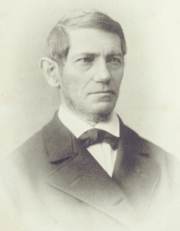
Carl Ferdinand von Arlt
Encyclopedia

Austrian Empire
The Austrian Empire was a modern era successor empire, which was centered on what is today's Austria and which officially lasted from 1804 to 1867. It was followed by the Empire of Austria-Hungary, whose proclamation was a diplomatic move that elevated Hungary's status within the Austrian Empire...
ophthalmologist who was born in Ober-Graupen
Krupka
Krupka is a town in the north-western part of the Czech Republic, in the Ústí nad Labem Region. It has about 14,000 inhabitants. There are 11 town parts in Krupka: Krupka, Bohosudov, Unčín, Maršov, Nové Modlany, Vrchoslav, Soběchleby, Horní Krupka, Habartice, Fojtovice and Mohelnice.-Origin of a...
, a village near Teplitz (Teplice)
Teplice
Teplice , Teplice-Šanov until 1948 is a town in the Czech Republic, the capital of the Teplice District in the Ústí nad Labem Region. It is the state's second largest spa town ....
in Bohemia
Bohemia
Bohemia is a historical region in central Europe, occupying the western two-thirds of the traditional Czech Lands. It is located in the contemporary Czech Republic with its capital in Prague...
. He earned his doctorate in Prague
Charles University in Prague
Charles University in Prague is the oldest and largest university in the Czech Republic. Founded in 1348, it was the first university in Central Europe and is also considered the earliest German university...
in 1839, and later became a professor of ophthalmology in Prague (1849-1856) and Vienna
University of Vienna
The University of Vienna is a public university located in Vienna, Austria. It was founded by Duke Rudolph IV in 1365 and is the oldest university in the German-speaking world...
(1856-1883). His son Ferdinand Ritter von Arlt (1842-1917) was also an ophthalmologist.
Arlt published a prodiguous number of books and articles concerning diseases of the eye, and collaborated with Albrecht von Graefe and Franciscus Donders
Franciscus Donders
-External links:* B. Theunissen. , F.C. Donders: turning refracting into science, @ History of science and scholarship in the Netherlands.* in the Virtual Laboratory of the Max Planck Institute for the History of Science* P. Eling, , Geneeskundige en fysioloog....
on the journal Archiv für Ophthalmologie. He was the first physician to provide proof that myopia
Myopia
Myopia , "shortsightedness" ) is a refractive defect of the eye in which collimated light produces image focus in front of the retina under conditions of accommodation. In simpler terms, myopia is a condition of the eye where the light that comes in does not directly focus on the retina but in...
(short-sightedness) is generally a consequence of excessive length of the sagittal axis of the eye. He is also credited for conducting annual eye clinics in impoverished areas.
The following eponyms are named after Arlt:
- Arlt's syndrome: a contagious eye infection caused by Chlamydia trachomatisChlamydia trachomatisChlamydia trachomatis, an obligate intracellular human pathogen, is one of three bacterial species in the genus Chlamydia. C. trachomatis is a Gram-negative bacteria, therefore its cell wall components retain the counter-stain safranin and appear pink under a light microscope.The inclusion bodies...
. - Arlt's operation: transplantation of eyelashEyelashAn eyelash or simply lash is one of the hairs that grow at the edge of the eyelid. Eyelashes protect the eye from debris and perform some of the same function as whiskers do on a cat or a mouse in the sense that they are sensitive to being touched, thus providing a warning that an object is near...
es back from the edge of the eyelidEyelidAn eyelid is a thin fold of skin that covers and protects an eye. With the exception of the prepuce and the labia minora, it has the thinnest skin of the whole body. The levator palpebrae superioris muscle retracts the eyelid to "open" the eye. This can be either voluntarily or involuntarily...
for treatment of distichiasis. - Arlt's line: Linear scar present in Sulcus subtarsalisSulcus subtarsalisSulcus subtarsalis is a groove in the innersurface of eyelid near the eyelid margin and which is also parallel to it. This separates marginal Conjunctiva from tarsal conjunctiva. It provides space for lodging of foreign bodies. Arlt's line is a linear line present in the sulcus subtarsalis in...
during Chlamydia trachomatisChlamydia trachomatisChlamydia trachomatis, an obligate intracellular human pathogen, is one of three bacterial species in the genus Chlamydia. C. trachomatis is a Gram-negative bacteria, therefore its cell wall components retain the counter-stain safranin and appear pink under a light microscope.The inclusion bodies...
infection. - Arlt's triangle: keraticKeratinKeratin refers to a family of fibrous structural proteins. Keratin is the key of structural material making up the outer layer of human skin. It is also the key structural component of hair and nails...
precipitates distributed in a wedge-shaped area on the inferior corneal endotheliumCorneal endotheliumThe corneal endothelium is a single layer of cells on the inner surface of the cornea. It faces the chamber formed between the cornea and the iris....
.
Selected publications
- Die Krankheiten des Auges (Diseases of the Eye) 3 volumes, (1851−1856)
- Operationslehre (Surgical Lessons) In Saemisch/Graefe Handbuch der gesamten Augenheilkunde Volume 3, (1874)
- Meine Erlebnisse. (Autobiography), Wiesbaden 1887, Otto BeckerOtto Heinrich Enoch BeckerOtto Heinrich Enoch Becker was a German ophthalmologist who was born near Ratzeburg. In 1859 he earned his medical doctorate from the University of Vienna, where he studied under Carl Ferdinand von Arlt...
, pupil of Arlt, completed his autobiography

